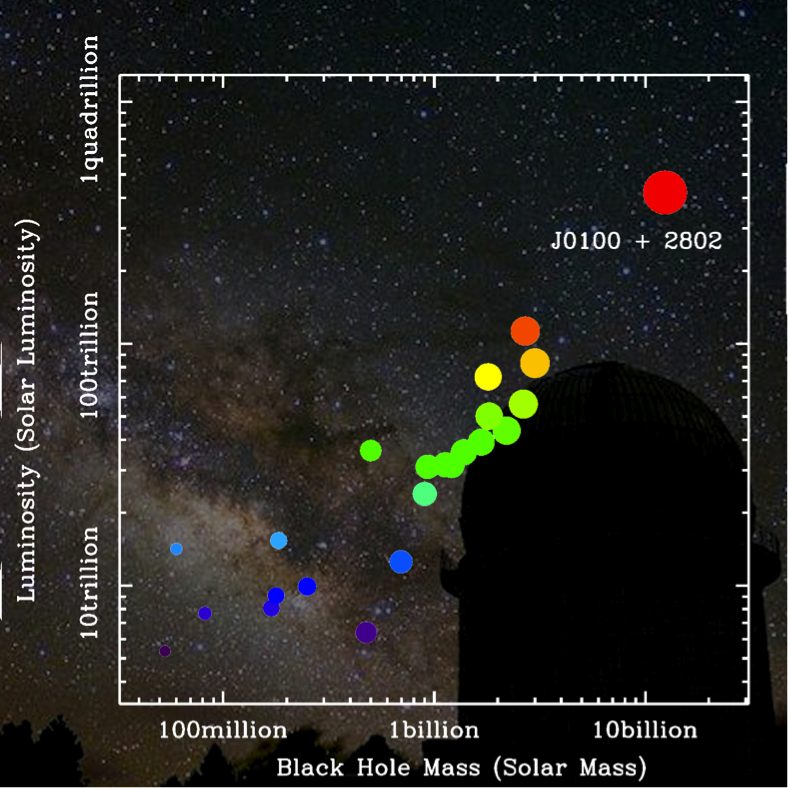Using the observational data from the 2.4 meter Lijiang Telescope in Yunnan China, the 6.5-meter Multiple Mirror Telescope, and the 8.4m Large Binocular Telescope in Arizona, USA, the 6.5m Magellan Telescope in Las Campanas Observatory, Chile, and the 8.2m Gemini North Telescope in Mauna Kea, Hawaii, USA, an international team led by Xue-Bing Wu, the associate director of Kavli Institute for Astronomy and Astrophysics (KIAA) and a professor at Department of Astronomy of Peking University, discovered a new quasar with a central black hole mass of 12 billion solar masses and a luminosity of 430 trillion solar luminosity, at a distance of 12.8 billions light years from the Earth. This is the most luminous quasar ever discovered in the early Universe, powered by the most massive black hole yet known at that time. The discovery of this quasar, named SDSS J0100+2802, marks an important step in understanding how quasars, the most powerful objects in the Universe, have evolved from the earliest epoch, only nine hundred million years after the Big Bang. This discovery was published in the top scientific journal Nature on February 26, 2015.
Discovered in 1963, quasars are the most powerful objects beyond our Milky Way Galaxy. They shine as their central supermassive black hole actively accretes surrounding materials. Thanks to large digital sky surveys, astronomers have discovered more than 200,000 quasars, ages ranging from 0.7 billion years after the Big Bang to today, with corresponding redshifts from 7.085 to 0.05. (Due to the expansion of the Universe, objects are moving away from us. Wavelength of light received by us is larger than that of the originally emitted light. Redshift is defined as the ratio of the wavelength difference to the original wavelength.)

Figure 1: An artist’s image of a quasar with a supermassive black hole in the distant Universe (Credits: Zhaoyu Li. The background images are from NASA/JPL-Caltech and Misti Mountain Observatory)
High-redshift quasars allow us to trace the structure and evolution of the early Universe. However, despite their high luminosity, they still appear faint due to their large distance, which makes them very difficult to find. Among the 200,000 quasars discovered to date, only about 40 are 12.7 billion light year away with redshift higher than 6.
In recent years, a team led by Xue-Bing Wu at Peking University has developed a method to effectively select quasars with redshift higher than 5 based on optical and near-infrared photometric data. With spectroscopic follow-up observations, they have systematically discovered a large number of new high-redshift quasars. SDSS J0100+2802 is one among them, but has the highest redshift.
The first optical spectrum obtained on December 29, 2013 by the 2.4m Lijiang Telescope shows that it is likely a quasar with redshift higher than 6.2. Active international collaborations allowed this team to further gather data from the Multiple Mirror Telescope, the Large Binocular Telescope, the Magellan Telescope, and the Gemini Telescope. By carefully analyzing these data, the team confirmed SDSS J0100+2802 as a quasar with redshift of 6.3 and estimated its intrinsic properties. At 430 trillion solar luminosity, this new quasar is 7 times brighter than the most distant quasar known (which is 13 billion years away). It harbors a black hole with mass of 12 billion solar masses, proving it to be the most luminous quasar with the most massive black hole among all the known high-redshift quasars.
“This quasar is very unique. We are so excited, when we found that there is such a luminous and massive quasar only 0.9 billion years after the Big Bang. Just like the brightest lighthouse in the distant Universe, its glowing light will help us to probe more about the early Universe.” said Xue-Bing Wu.
“This quasar was first discovered by our 2.4 meter telescope in Lijiang, Yunnan, China.” said Feige Wang, a PhD graduate student from Peking University. “It is also currently the only one quasar with redshift larger than 6 ever discovered by a 2-meter telescope in the world. We are very proud of it.”
“Discovery of this ultra-luminous quasar yields a strong limit to the theoretical model of black hole growth in the early Universe and stands for the claim that black holes probably grow faster than host galaxies at early times. This ultra-luminous quasar with a 12 billion solar mass black hole provides a unique laboratory to the study of the mass assembly and galaxy formation around the most massive black hole in the early Universe,” added Prof. Xiaohui Fan, a visiting Chair Professor at KIAA and a Chinese-American astronomer from the University of Arizona, who is part of this team.
To unveil more scientific secrets behind this unique quasar, this research team will carry out further investigations with more international telescopes, including the Hubble Space Telescope.

Figure 2: The newly discovered quasar SDSS J0100+2802 is the one with the most massive black hole and the highest luminosity among all known distant quasars (Credits: Zhaoyu Li. The background photo, provided by Yunnan Observatories, shows the dome of the 2.4meter Lijiang Telescope and the sky over it)
The research of the team was supported by the NSFC, CAS pilot-B, and the Chinese MOST 973 program, as well as the US NSF.
The weblink of Nature paper:http://www.nature.com/nature/journal/v518/n7540/full/nature14241.html
The webpage of Nature News Press on the paper:
http://www.nature.com/news/young-black-hole-had-monstrous-growth-spurt-1.16989
The weblink of Nature News and Views article on the paper:http://www.nature.com/nature/journal/v518/n7540/full/518490b.html
Some news reports about this discovery:
Washington Post:Astronomers find a shockingly ancient black hole the size of 12 billion suns; http://www.washingtonpost.com/news/speaking-of-science/wp/2015/02/25/ast...